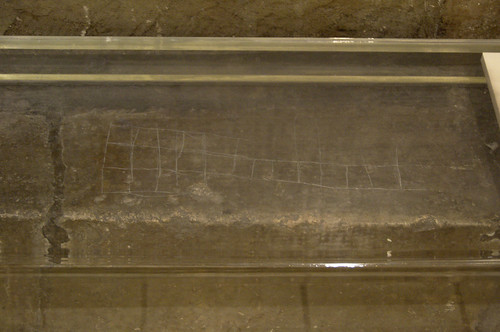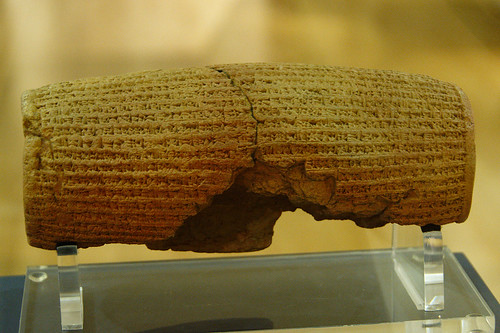Sappho was a 7th Century BC Greek poetess, but I rather suspect the thing she’s best known for in modern culture is for being the reason we call lesbians lesbians. However, it was for her poetry that she was renowned in ancient Greece. Discussing a little bit about the woman and a lot about her work on In Our Time were Edith Hall (King’s College, London), Margaret Reynolds (Queen Mary, University of London) and Dirk Obbink (University of Oxford).
Saphho lived on Lesbos, which is an island between mainland Greece and Turkey – both in a geographical sense and in a cultural sense. Whilst they were definitely Greek there were eastern influences on both their culture and their language. Their dialect of Greek was not the same as the Greek of Homer and would’ve sounded a bit exotic to the mainland Greek people of her time. She was a lyrical poet, which means that her words were set to music – accompanied by the lyre or other instruments. The work of a lyrical poet was an important part of ceremonies, and was also important to memorialise events. Obbink said that what survives is a bit like having the words to an opera, but not the music.
To the Greeks Sappho was “The Poetess” in the same was that Homer was “The Poet”. A lot of her work was written down and still read long into the classical era. In the Library at Alexandria there was a 9 volume text containing all her poetry. But most of what survived to be rediscovered in the Renaissance did so as fragments in other texts – later translations and quotations in textbooks and commentaries. Much more recently papyrus fragments have been discovered from what were originally whole poems written in her native dialect – I hesitate to say originals as I think these would post-date her time but it would be like discovering fragments of a “Complete Works of Shakespeare” after only knowing his work via quotations from other books in modern English. More of these papyrus fragments occasionally get discovered – Obbink has recently found and translated some previously unknown fragments. These can radically change our understanding of a poem where they overlap with previously known pieces.
The subjects of her poetry were very personal in nature rather than mythical as is the case with Homer. Her poems contain several expressions of her desire for and love of other women, hence her later reputation as a lesbian. Some of the language and metaphors that she uses for desire have become a standard part of the repertoire of imagery – e.g. fire in the veins. The people in her poems are often specific named people, and she names herself in her poetry as well. Despite the first person perspective and specificity of the poetry it’s not clear if it was actually autobiographical. In particular it’s not clear if she was actually a lesbian, and if she was it’s not clear if anyone in her culture at the time cared (although it is clear that they did care later on).
Hall suggested that Sappho’s poetry might indicate that in her time and place there were women’s symposiums running in parallel to the men’s ones. Men’s symposiums are well attested through Greek culture. Hall explained them as semi-public gatherings which in effect provided poetic and ritualised training of the next generation in how to be civilised. They were where a young Greek man learnt how to be “a Greek man”. There are no records of women’s symposiums, and in parts of the classical Greek world (like classical Athens) women’s lives were so restricted that they seem implausible as an idea. However Sappho’s time and place were different, and women’s voices survive so rarely from this era (I’m not sure if Sappho is unique or just almost so) that no evidence is not the same as evidence of absence.
In her own time and during later Greek culture Sappho’s poetry was very popular. However she began to become less revered during the Roman period. Her dialect of Greek had died out and so understanding her poetry wasn’t a question of picking up the text and reading it, it required a commentary or a translation. It became even more obscure in the Christian era when it dropped out of the standard curriculum altogether because the subject matter was too much about worldly, sinful things like desire for a beautiful woman. And because of her obscurity her work was not often copied, and thus no copies survived intact. Fragments of her work were only discovered in the late Renaissance, and early translations downplayed the sauciness of the texts.
Since rediscovery Sappho’s work, and Sappho herself, have often been taken up by the women’s movements of various eras. Because there is so little known about the woman herself, and even her work, it’s relatively easy to shape her into an icon. Whether that is for intellectual liberation as in the 18th Century or the sexual liberation of the 20th Century. One of the experts suggested that it’s also because of the position of Greek culture in our own culture as one of the “roots of civilisation”. As the vast majority of what survives from Greece is male voices and male culture that can lead to an equation of men with civilisation. So if you’re putting forward women as the equal of men against this cultural backdrop it’s good to have an example of a feminine Greek culture.
This programme concentrated on the poetry and the legacy of Sappho rather than the woman herself – as there is so very little that’s actually known about her. So it was well complemented by the TV programme “Sappho: Love & Life on Lesbos with Margaret Mountford”, which we watched not long after listening to this. The TV programme was more focussed on Sappho the person – although of necessity it was more about the broader culture of the period than the individual. It also looked at the legends that have grown up around the woman in more modern times.


